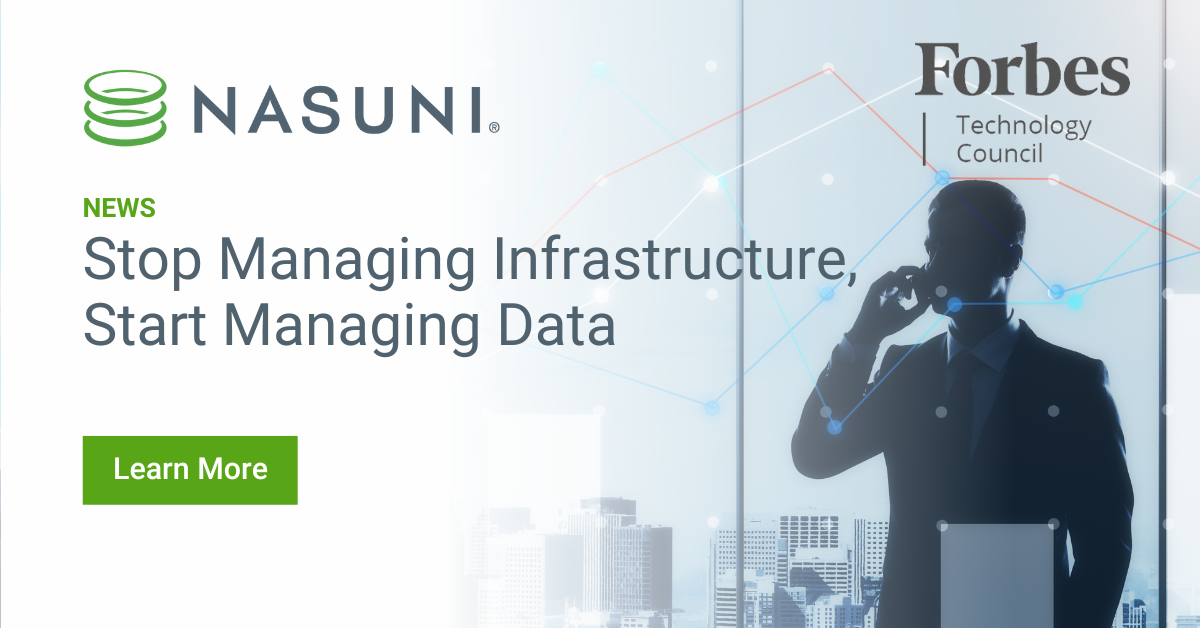Stop Managing Infrastructure, Start Managing Unstructured File Data
Nasuni’s Russ Kennedy discusses how enterprises can transition to managing unstructured file data in the cloud.
May 17, 2023

An exciting shift is underway in the world of enterprise data. For the last several decades, unstructured file data has been inextricably bound to hardware. The stewards of data within large organizations were forced to focus on procuring, managing and maintaining the infrastructure on which that data resided. Whether they were managing storage devices, data centers, failover sites, networking equipment, backup solutions, tape drives or some complex mix of all of the above, they were stuck in the hardware business. And every few years, they were forced to buy vendors’ latest boxes and migrate their data to that new gear.
Those days are gone. The cloud-driven evolution of capabilities in data storage and protection has rendered much of that once-critical legacy technology obsolete. Organizations can leverage more advanced data services through the cloud and do so without investing in hardware. You can stop managing infrastructure and start managing data.
I’m not the only one highlighting this change. Gartner Research VP Julia Palmer, who covers emerging infrastructure technologies and strategies, encapsulates this trend in an October 2022 report.
When your data is no longer anchored to a specific facility, location or piece of hardware, you can start to think about new ways of putting that data to work for your organization. First, though, you’ll have to shift your strategic thinking around data management and data delivery by focusing on three basic rules or requirements.
Move your data to the cloud now.
The reasoning behind this first one should be obvious. The business and technological benefits of migrating your unstructured file data to the cloud were obvious enough several years ago when the favorable economics and unlimited scale of object storage, in particular, established cloud services as the future of infrastructure. The changes wrought by the pandemic have only strengthened the case for the cloud. Adopting cloud services is no longer simply a matter of reducing your long-term costs, shrinking your physical infrastructure and scaling efficiently on demand. The cloud is enabling more agility in your business and changing what you can do with data.
Focus on delivering data.
The move away from traditional infrastructure has been in progress for some time, but the rise of hybrid and remote work accelerated the change. In the past, most of your users were stationed at their desks, close to the hardware that stored and protected their data. They were grounded in a relatively small number of specific spots. Now they’re everywhere. A typical large organization might have users working from HQ, job sites, home offices, co-working spaces, client or partner offices and cafés. Depending on the industry, we’ll see people in manufacturing plants, gaming studios or remote sites. Users don’t stay put, either. They shift between locations, and they expect to be able to access their data quickly and efficiently regardless of where they need to work on a given day.
This means the applications they rely on have to be running close to their data. Applications right now are in a transitional phase. Some have shifted to the cloud in some form, while others are moving in that direction. These applications could be general, familiar ones that we all know and use or more industry-specific. At my company, we deal with plenty of enterprises that depend on homegrown apps as well. Yet the same rule applies to each use case: Applications need to be close to their data to deliver an expected level of performance and increase productivity.
When everyone was in one assigned spot, this wasn’t a challenge. But if your data lives in one location, and you’re somewhere else, working in an application that needs that data to run effectively, the performance is going to be very poor if you’re relying on traditional storage hardware and wide area networks because the software needs to reach across the wire to access that data. This is where we have been starting to see the critical importance of cloud as a data delivery vehicle. Once you move your data to the cloud through an effective services provider, you have increased flexibility to deliver it to users and applications in global locations at all times.
Don’t sacrifice strong protection.
While delivering data is essential, it should not come at the expense of data protection. Ransomware was a problem before the pandemic-induced shift to hybrid and remote work, but there are significantly more opportunities for malicious hackers today because the attack surface has expanded. More people are accessing data and systems from more places. So as you think about how to support the flexibility of hybrid work models, you need to do so in a way that focuses on protecting data as much as delivering data.
You can’t ignore one and focus on the other. Insisting on keeping your employees in a few major locations for the sake of data protection will reduce productivity and, in all likelihood, degrade your talent pool. At the same time, freely distributing data everywhere without a testable, reliable and rapid ransomware recovery plan will leave you at risk of extended business downtime or financial exposure.
Even with the threat of ransomware, the transition from managing infrastructure to managing unstructured file data could not have happened at a better time. It aligns perfectly with this new way of working, which has users in one location one day, then another the next, and collaborating with partners, suppliers, contractors and other outsiders potentially all over the world. The data center is no longer the center of data, and I believe this is only the beginning and that we’re on the cusp of much larger changes. Data itself is now the center, and what organizations choose to do with this newly accessible data is going to be incredibly exciting. But I’ll leave that for a future post.